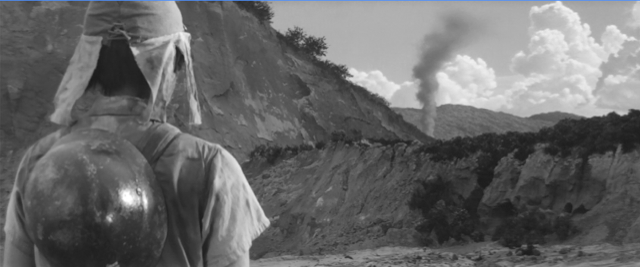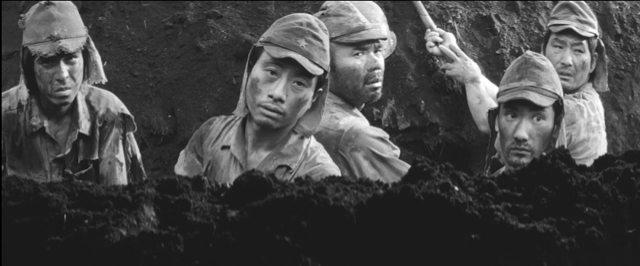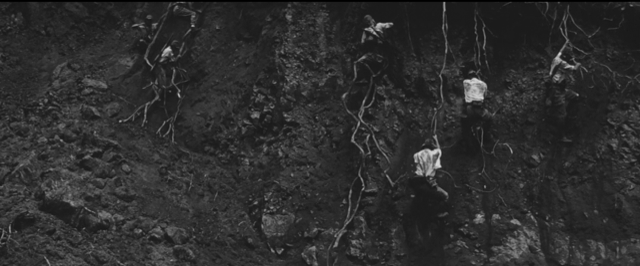| Ryan Sanderson |

Fires on the Plain plays on glorious 35mm at the Trylon Cinema from Friday, May 2nd, through Sunday, May 4th. For tickets, showtimes, and other series information, visit trylon.org.
Fires on the Plain begins with a literal slap to the face. Cruel, jarring, and just a little bit funny. That’s the energy Kon Ichikawa maintains throughout his bleak and disturbing masterpiece which feels like a cross between Apocalypse Now and Bambi. If a film before 1960 captured the absurdity of war better, I’ve yet to see it. Private Tamura (Eiji Funakoshi) receives that slap from his commanding officer in the middle of an absurd back and forth between the hospital, which won’t accept him because he’s not sick enough, and his battalion, which won’t accept him because he’s too sick. Scattered and starving on a strange island and hunted by the far better equipped Americans, these Japanese soldiers dig trenches with their hats and pass the days foraging for just enough food to survive. They can’t afford to feed and take care of someone with tuberculosis, so Tamura’s CO gives him one final command: he’s to return to the hospital one more time, and if they won’t accept him, he should blow himself up with a hand grenade.
Critics at the time called the film excessively bleak. Its profile has grown the last sixty-five years, and today it’s considered one of the greatest films ever made on the subject of war. Ichikawa spent his early career making comedies, citing Charlie Chaplin and Walt Disney as inspiration. Both influences are strong in this film, and their meticulous timing and tonal sentimentality help balance out the film’s bleakness. Other times, they amplify it.
Tamura walks the world with a befuddled, exhausted look on his face. He affectionately watches an ant on his finger until it bites him. Then he feels sadistic glee when stabbing an attacking dog. Someone steals his food, so later on he’s more hesitant about offering food to someone else. Affection, betrayal, and bloodlust all pass through him as though he’s a child experiencing them for the first time. Perhaps this innocence protects him from the worst cruelty and cynicism of men around him. Men who sniff around food like hungry wolves and smile desperate, shallow smiles to hide their true intentions. Others are kinder. The corporal at Tamura’s camp sneaks him a few yams on the way out the door and tells him, “Don’t kill yourself unless you have to.” This is humanity on the Pacific front.

Director Kon Ichikawa, who witnessed firsthand the aftermath of American nuclear attacks in Hiroshima and Nagasaki, said he wanted to capture, “the limits in which moral existence is possible.” As starvation, desperation, and terror ramp up, as order collapses, characters devolve to increasingly desperate and unhinged states. Men laugh conversationally, then casually mention how they were forced to resort to cannibalism. Suddenly that performance of civility takes on new menace. How much actually remains? How much does the quieter fantasy Tamura seems to live in match the violence of his circumstances? Each new sequence pushes him a little further away.
As a remedy to all this bleakness, the film offers the blackest of black comedy. The visual storytelling is so crisp, the individual images so engagingly composed, the performances so evocative—it truly does feel like a Walt Disney animated film. Tamura wanders the earth with a frightened curiosity that feels almost like Bambi or Pinnochio wandering scared through a strange and threatening world. The harder that world spirals out of control, the less magical and composed the images become. But we’re still left feeling those horrors through Tamura’s gauzy, sentimental perspective, which ultimately means we’re all the more horrified when we discover that violence has no romanticization whatsoever.
However unsightly or unpleasant individual selfishness between the soldiers had been, it’s nothing compared to the violence of true combat. The camera lingers on the ugliest, most grotesque images, feeling almost lurid in places. When the violence explodes, it’s grotesque and shocking (though still immaculately framed).

The title comes from the fires that starving Japanese soldiers see in the distance. Are these American campfires, smoke signals, the strange burning remnants of bombs? Some men imagine themselves surrendering, being taken in by the Americans as prisoners of war, provided with food, shelter, and rest. When someone finally acts on that assumption, we witness the results with horror though not surprise. However, it’s not Americans who kill the unlucky soldier. It’s a Phillipino soldier, clearly enraged by what the Japanese soldiers have done while occupying her home country. They are aggressors just as much as they are victims—indeed, the film wants the audience to arrive at a place where the distinction between victim and aggressor is solely a matter of who has the better weapon.
Film, of course, came of age during the same century where more people were killed in war than any other in human history. Its ability to preserve experience in such a direct way inarguably had a huge influence on how these subjects are understood, on human consciousness as a whole. For the first time people all over the world could see the losers’ perspective. People in the heart of empires could literally see events through someone else’s eyes. It’s an unbelievably powerful phenomenon and I think it contributes to why we treasure cinema history so much. It’s part of what makes the art form sacred. (This power has also been abused quite a bit, but I’ve got a limited word count).

Filmmakers have all sorts of different approaches and ethoses for making war films. Great filmmakers can disagree with each other. Fires on the Plain feels strange in this regard. Rhetorically, it feels more like the antiwar films of the present moment, cynical towards any idealization, focused more on the inhumanity of circumstances than the righteousness of the cause. But it also comes from an older storytelling tradition, one we associate with fairy tales and highly structured classic Hollywood storytelling. It’s like using a whole discordant orchestra to achieve the same effect someone else would get with a single fingernail scraping a chalkboard. I love it for this reason. I think there’s a real virtue to the fact that it doesn’t numb you with horror, but instead slowly assaults you with queasiness until you’re overwhelmed with feeling. In this way I think it fulfills the primary duty of an anti-war film as I understand it, as successfully as any film I have ever seen—it cements its horror and hard-won insight into the audience’s mind in a way that is very, very difficult to forget.
Edited by Olga Tchepikova-Treon
